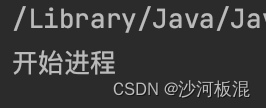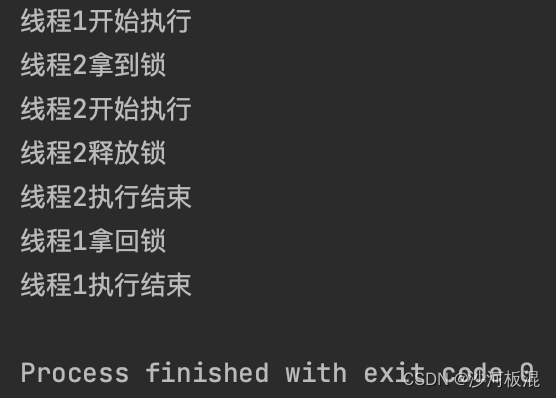1、wait和notify
Java的多线程中,线程的执行顺序和时间都是不定的。为了控制线程的调度顺序,前面我们引入了join()方法。
但是join()只能在线程执行完后,才能执行其他线程,有没有什么方法可以在线程执行顺序中来调度其他线程呢?
这里我们引入了wait()和notify()方法
wait()、notify()和notifyAll()都是属于Object类中的方法,任何对象都可以调用这几个方法
wait()/wait(time):让当前进程进入阻塞状态
notify()/notifyAll():唤醒当前对象上等待的对象
wait()的基本用法是
Object object = new Object();
synchronized (object){try {object.wait();} catch (InterruptedException e) {throw new RuntimeException(e);}notify()基本用法
synchronized (object){object.notify();
} 2、注意事项
(1)wait()和notify()在使用时都要加锁
在使用上述三个方法时,需要对竞争资源进行加锁,不然就会报错
![]()
并且wait()方法在使用时,线程必须获得锁对象的控制权
(2)阻塞状态
线程调用wait()方法后,线程进入阻塞状态(WAITING)
阻塞状态什么也不做,不会占用CPU

(3) notify的调用位置
对象调用wait方法后,对象锁被释放,这时必须由其他线程来唤醒对象
如果将notify写在同一线程中,则不能唤醒当前对象
public class demo {public static void main(String[] args) {Object object = new Object();System.out.println("开始进程");synchronized (object){try {object.wait();} catch (InterruptedException e) {throw new RuntimeException(e);}object.notify();}System.out.println("结束进程");}
}线程会继续阻塞

3、wait()带参数方法和notifyAll()
(1)wait()带参数方法
wait(long timeout)中的参数表示线程阻塞的超时时间,如果超过这个时长,那么线程会被自动唤醒
避免无休止地等待下去
public class demo {public static void main(String[] args) {Object object = new Object();Thread thread1 = new Thread(()->{synchronized (object){System.out.println("线程1开始执行");try {object.wait(1000);} catch (InterruptedException e) {throw new RuntimeException(e);}System.out.println("线程1执行结束");}});Thread thread2 = new Thread(()->{System.out.println("线程2开始执行");System.out.println("线程2执行结束");});thread1.start();thread2.start();}
}
上述代码中,并没有对线程1进行唤醒操作,而是在1000ms的等待时间结束后,线程1自动唤醒,打印结果并结束线程
(2)notifyAll()
notify()一次唤醒一个线程,notifyAll() 一次唤醒全部线程
由于唤醒线程的过程中也要进行锁的竞争,因此notifyAll()的唤醒并不是并行执行,而是串行执行的
· 多次notify()唤醒多个线程
public class demo {public static void main(String[] args) {Object object = new Object();Thread thread1 = new Thread(()->{synchronized (object){System.out.println("线程1开始执行");try {object.wait();} catch (InterruptedException e) {throw new RuntimeException(e);}System.out.println("线程1拿回锁");System.out.println("线程1执行完毕");}});Thread thread2 = new Thread(()->{synchronized (object){System.out.println("线程2开始执行");try {object.wait();} catch (InterruptedException e) {throw new RuntimeException(e);}System.out.println("线程2拿回锁");System.out.println("线程2执行完毕");}});Thread thread3 = new Thread(()->{try {Thread.sleep(2000);} catch (InterruptedException e) {throw new RuntimeException(e);}synchronized (object){System.out.println("线程3开始执行");object.notify();object.notify();System.out.println("线程释放锁");System.out.println("线程3执行完毕");}});thread1.start();thread2.start();thread3.start();}
}
线程3唤醒两次,使得线程1和线程2先后拿回锁

· notifyAll()
public class demo {public static void main(String[] args) {Object object = new Object();Thread thread1 = new Thread(()->{synchronized (object){System.out.println("线程1开始执行");try {object.wait();} catch (InterruptedException e) {throw new RuntimeException(e);}System.out.println("线程1拿回锁");System.out.println("线程1执行完毕");}});Thread thread2 = new Thread(()->{synchronized (object){System.out.println("线程2开始执行");try {object.wait();} catch (InterruptedException e) {throw new RuntimeException(e);}System.out.println("线程2拿回锁");System.out.println("线程2执行完毕");}});Thread thread3 = new Thread(()->{try {Thread.sleep(2000);} catch (InterruptedException e) {throw new RuntimeException(e);}synchronized (object){System.out.println("线程3开始执行");object.notifyAll();System.out.println("线程释放锁");System.out.println("线程3执行完毕");}});thread1.start();thread2.start();thread3.start();}
}
执行结果

3、关于锁释放的时间
在线程2唤醒 线程1后,线程2会立即释放锁吗?
我们通过一段代码来验证一下
public class demo {public static void main(String[] args) {Object object = new Object();Thread thread1 = new Thread(()->{synchronized (object){System.out.println("线程1开始执行");try {object.wait();} catch (InterruptedException e) {throw new RuntimeException(e);}System.out.println("线程1拿回锁");System.out.println("线程1执行结束");}});Thread thread2 = new Thread(()->{synchronized (object){System.out.println("线程2拿到锁");System.out.println("线程2开始执行");System.out.println("线程2释放锁");object.notify();try {Thread.sleep(2000);} catch (InterruptedException e) {throw new RuntimeException(e);}System.out.println("线程2执行结束");}});thread1.start();thread2.start();}
}
上述代码执行结果为:

可以看到,在线程2调用notify()唤醒线程1后,就算进行了休眠,也并没有释放锁;而是在线程2的代码全部执行完后,线程2才释放锁
所以,我们可以得出的结论是:在一个线程唤醒其他线程后,它不会立即释放锁,而是要在本线程代码执行完后才释放锁



】硬件系统由标量指令、向量指令、张量指令、访存指令构成)


)


】BANGC 报错 stack smashing detected)









